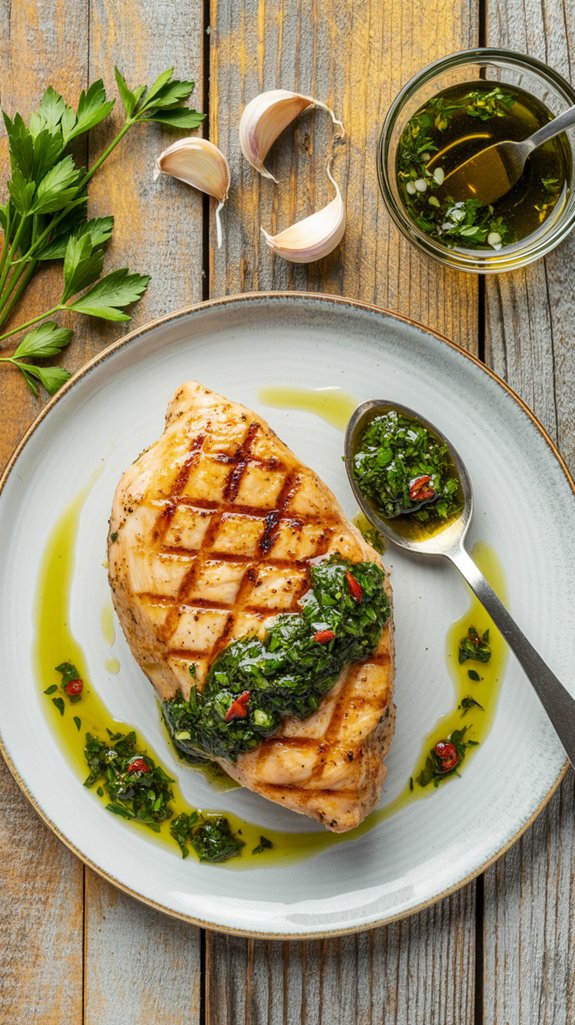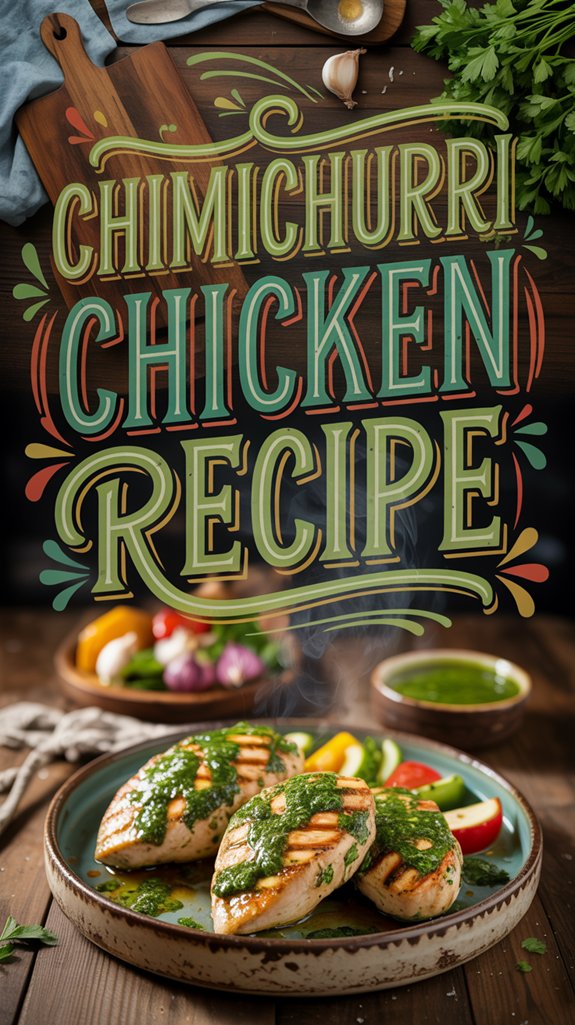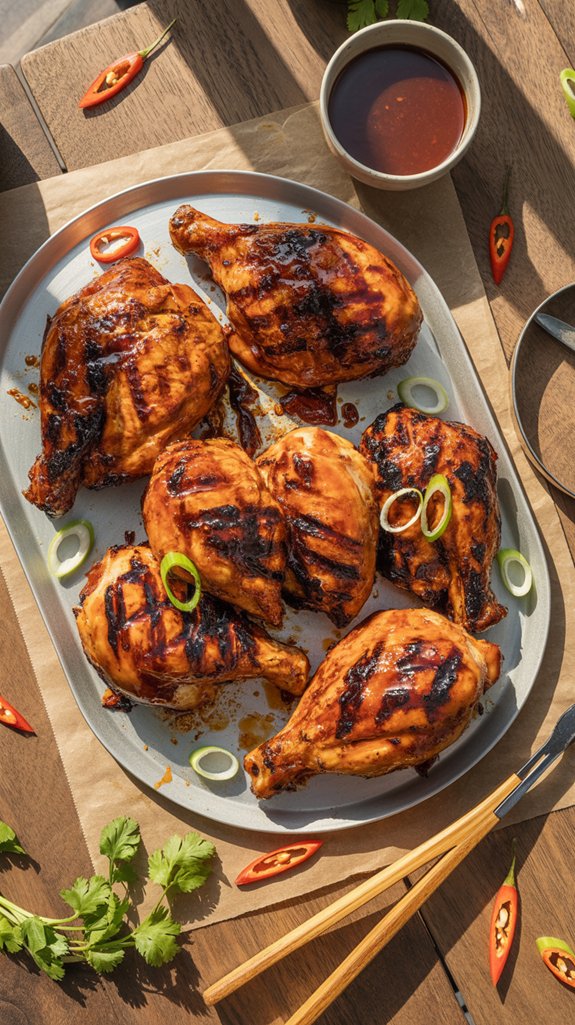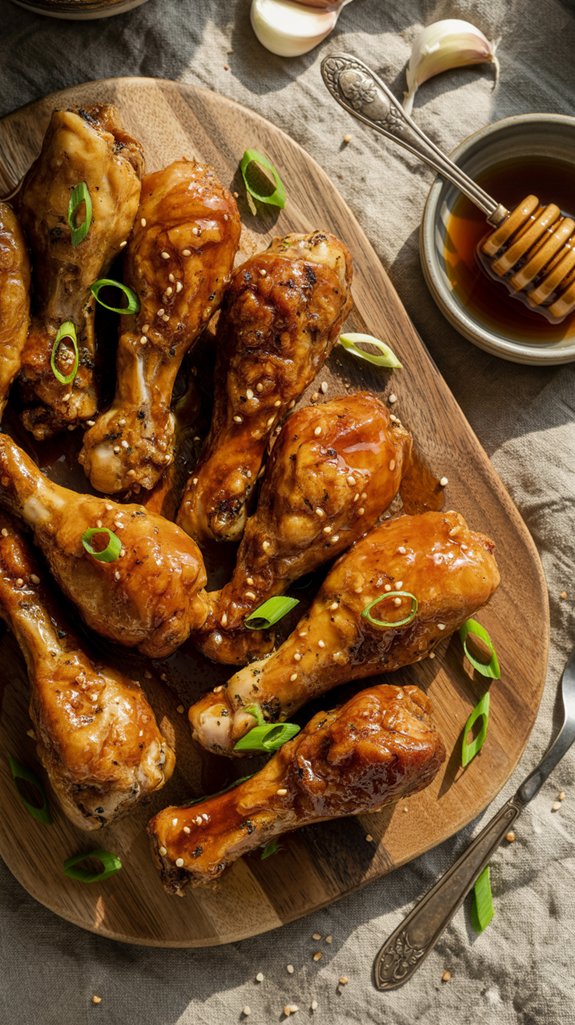Why You’ll Love This this Argentinian Chimichurri Chicken
This chimichurri chicken is basically summer on a plate, with all that fresh parsley and garlic creating the most incredible herbaceous marinade that makes your kitchen smell like an Argentinian steakhouse.
The beauty of this recipe lies in its simplicity—you just toss everything into a bag, let time work its magic for a few hours, and then grill or pan-fry your way to tender, flavorful chicken that’s bursting with bright, zesty flavors.
Whether you thread these strips onto skewers for a fun presentation or just cook them up in a hot pan, you’re looking at restaurant-quality results with minimal effort and maximum flavor payoff.
Ingredients List
Let’s plunge into what you’ll need to create this flavor-packed Argentinian chimichurri chicken that’ll have your taste buds doing a little tango.
- 1 1/2 lbs boneless skinless chicken breasts, cut in strips
- 1 cup minced parsley (about 1/2 bunch)
- 3 cloves garlic, minced
- 1/3 cup olive oil
- 1/4 cup red wine vinegar
- 2 tablespoons lemon juice
- 1/2 teaspoon salt
- 1/2 teaspoon coarse grind black pepper
- 1/2 teaspoon dried oregano or 1 teaspoon fresh oregano
- 1/4 teaspoon cayenne pepper
A few ingredient notes worth mentioning:
- This recipe is naturally lean protein-forward, which means you’re getting plenty of protein without heavy sauces or breading weighing things down
- The olive oil provides healthy fats while the fresh herbs pack in antioxidants and vitamins, so you’re basically eating a vitamin bomb disguised as dinner
- Keep in mind the sodium content is relatively low, but if you’re watching your salt intake, you can easily cut back on the added salt since the other flavors are bold enough to carry the dish
- The garlic and herbs offer natural anti-inflammatory benefits, making this a pretty wholesome choice that doesn’t taste like health food
Step by Step Directions
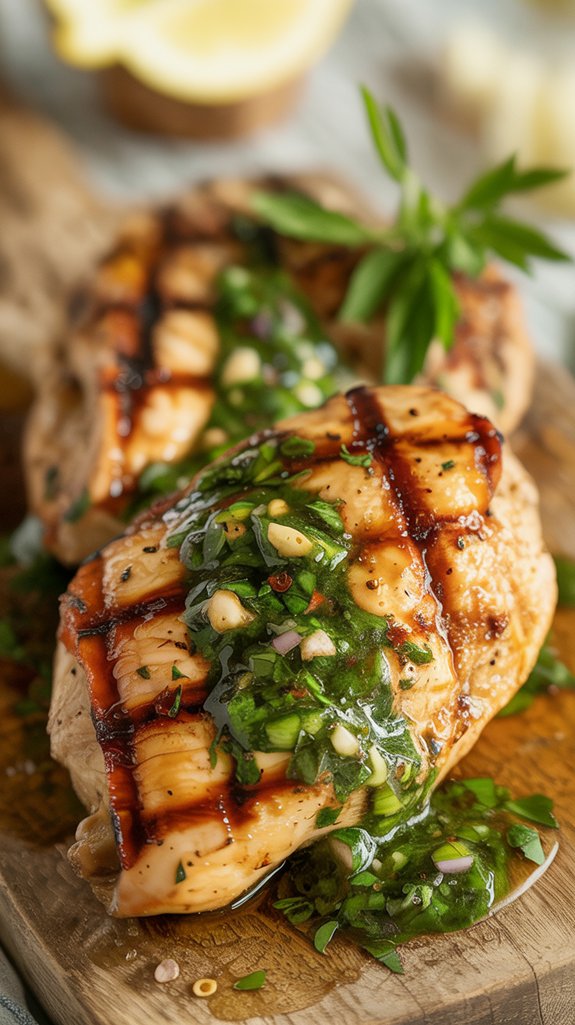
Making this Argentinian chimichurri chicken is as straightforward as it gets – just marinate, then cook until perfectly charred.
- Combine all ingredients in a plastic zipper bag.
- Marinate chicken strips for at least 4 hours.
- Remove chicken from marinade and discard remaining marinade.
- Thread chicken onto skewers if grilling (recommended method).
- Grill chicken until thoroughly cooked, or alternatively pan-fry until very brown for about 5 minutes per side.
For the best results when pan-frying, use proper Indian cooking equipment to achieve even heat distribution and optimal browning.
Substitutions and Variations
• Herb variations – Some recipes include cilantro mixed with the parsley, which adds a fresh, bright note.
Start with half cilantro, half parsley if you’re curious but not totally committed to the idea.
• Garlic intensity – Three cloves might seem like a lot, but garlic lovers can easily bump this up to four or five.
Vampire protection included at no extra charge.
Additional Things to Serve With This Dish
These chimichurri chicken strips play well with others, and honestly, that’s half the battle when you’re trying to put together a meal that doesn’t look like you just grabbed random things from your fridge.
- Rice and grains – Plain white rice is the classic move here, but coconut rice or cilantro-lime rice will make you look like you actually planned this whole thing. Quinoa works too if you’re feeling fancy or need to sneak some protein past picky eaters.
- Grilled vegetables – Zucchini, bell peppers, and red onions get that same smoky char as the chicken, plus they’re basically cooking themselves while you focus on not burning the meat.
- Simple salads – A basic mixed green salad with a light vinaigrette won’t compete with all that herby goodness. Or go full Argentine with a tomato and onion salad dressed with olive oil and vinegar.
- Bread situation – Crusty bread or warm tortillas for wrapping everything up, because sometimes you just need carbs to hold your life together. Naan works in a pinch too.
- Roasted potatoes – Cut them small so they actually finish cooking before everyone gets hangry, toss with olive oil and salt, then forget about them in the oven for 30 minutes.
Cooking Tips & Tricks (Chef’s Notes)
• Save some fresh chimichurri for serving – Make a double batch of the sauce, use half for marinating and keep the other half clean for drizzling over the finished chicken.
Trust me on this one.
• Let it rest for a few minutes – Just like any other protein, these strips need a moment to relax after cooking so all those juices redistribute instead of running all over your cutting board.
Nutritional Facts
This protein-packed dish delivers excellent nutritional value with lean chicken breast as the star ingredient.
- High in protein – Each serving provides approximately 35-40 grams of complete protein to support muscle health and satiety.
- Heart-healthy fats – The olive oil contributes beneficial monounsaturated fats that support cardiovascular health.
- Low in carbohydrates – With less than 2 grams of carbs per serving, this dish fits well into low-carb eating plans.
- Rich in antioxidants – Fresh parsley and garlic provide vitamin C, vitamin K, and powerful antioxidant compounds.
- Moderate calories – Each serving contains roughly 280-320 calories, making it a satisfying yet reasonable meal option.
- Good source of B vitamins – Chicken breast naturally provides niacin, B6, and B12 for energy metabolism and nervous system function.
- Anti-inflammatory properties – The herbs and spices, particularly oregano and garlic, contain compounds that may help reduce inflammation.
Fun “Did You Know?”
While chimichurri‘s now synonymous with Argentine cuisine, food historians believe this vibrant green sauce actually originated from Basque immigrants who settled in Argentina during the 19th century.
I find it fascinating that chimichurri’s name might derive from “tximitxurri,” a Basque word meaning “a mixture of several things in no particular order.”
Another theory suggests it comes from “Jimmy McCurry,” an Irish soldier who supposedly created the sauce.
What’s certain is that Argentine gauchos popularized chimichurri as their go-to condiment for grilled meats, transforming it into the national sauce we recognize today.

